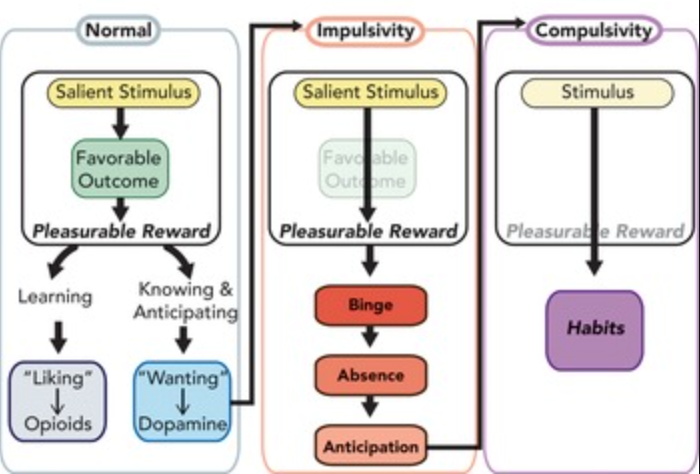From Impulsivity to Compulsivity in Addiction: The Cortical-to-Subcortical and Ventral-to-Dorsal Migration
Introduction
Addiction is a complex neurobiological process that progresses from impulsive drug-seeking behavior to compulsive substance use. This transition is underpinned by changes in neural circuits, specifically a shift from cortical to subcortical regions, as well as from the ventral striatum to the dorsal striatum, as described in Stahl’s Essential Psychopharmacology. These dual migrations explain why addiction evolves from pleasure-seeking (impulsivity) to habitual, compulsive drug use despite negative consequences.
Understanding the Brain’s Role in Addiction
Addiction involves two major neurobiological transitions:
- Cortical to Subcortical Shift – Initially, drug use is regulated by cortical executive control mechanisms but progressively shifts to subcortical structures where automatic, habitual behaviors dominate.
- Ventral to Dorsal Striatum Shift – The transition from goal-directed drug use (ventral striatum) to habitual and compulsive drug-seeking (dorsal striatum).
Stage 1: Impulsivity and Cortical Control
In the early stages of addiction, drug use is primarily driven by positive reinforcement. The individual consumes a substance to experience its pleasurable effects.
- Brain Regions Involved:
- Prefrontal Cortex (PFC) – Responsible for decision-making, impulse control, and evaluating consequences.
- Ventral Striatum (Nucleus Accumbens) – Processes rewards and reinforces motivation.
- Neurotransmitters: Dopamine release from the ventral tegmental area (VTA) enhances motivation and reward-seeking behavior.
- Behavioral Features:
- Drug-seeking is goal-directed and influenced by environmental cues.
- The prefrontal cortex exerts some control over impulsive decisions.
At this stage, addiction is primarily impulsive, meaning the individual engages in substance use due to momentary desires or environmental stimuli that trigger the urge.
Stage 2: Transition from Cortical to Subcortical and Ventral to Dorsal Striatum
With repeated drug use, neuroplastic changes occur, shifting the control of behavior from cortical to subcortical structures and from the ventral to the dorsal striatum. This transition represents the brain’s adaptation to chronic substance use, reinforcing habitual behaviors.
- Neural Adaptations:
- The dopamine system undergoes desensitization, requiring higher doses for the same effect (tolerance).
- Glutamatergic projections from the prefrontal cortex to the striatum are altered, weakening cognitive control over drug-seeking behaviors.
- Drug-seeking becomes less about experiencing pleasure and more about avoiding withdrawal or distress.
Stage 3: Compulsivity and Subcortical Dominance
As addiction progresses, drug-seeking behavior becomes compulsive rather than impulsive. At this stage, the individual continues using substances despite knowing the harmful consequences.
- Brain Regions Involved:
- Dorsal Striatum (Caudate and Putamen) – Habitual behaviors become entrenched.
- Amygdala and Hippocampus – Emotional memory and stress-related triggers play a larger role.
- Neurotransmitters: The role of glutamate increases, reinforcing habitual drug-seeking behaviors.
- Behavioral Features:
- Negative reinforcement becomes the primary motivator (i.e., using drugs to relieve withdrawal symptoms or emotional distress rather than to experience pleasure).
- The prefrontal cortex’s executive control diminishes, reducing the ability to resist cravings.
- Substance use becomes an automatic, ingrained habit, even in the absence of external cues.
Clinical Implications
Understanding the cortical-to-subcortical and ventral-to-dorsal shift in addiction highlights several important aspects of treatment:
- Early Intervention: Targeting impulsivity in early addiction stages with cognitive behavioral therapy (CBT) can prevent the progression to compulsive drug use.
- Neuromodulation Strategies: Techniques such as transcranial magnetic stimulation (TMS) can help restore prefrontal control over the dorsal striatum.
- Medications: Agents like naltrexone, buprenorphine, and varenicline can modulate the dopamine system to reduce cravings and relapse risk.
- Behavioral Therapies: Mindfulness-based interventions can help increase awareness of automatic drug-seeking behaviors, enabling individuals to disrupt compulsive habits.
Conclusion
Addiction follows a cortical-to-subcortical and ventral-to-dorsal migration, shifting from impulsive, goal-directed drug-seeking controlled by the prefrontal cortex to compulsive, habitual substance use dominated by subcortical structures like the dorsal striatum. This progression underscores the importance of early interventions to prevent addiction from becoming an entrenched habit. Understanding these neurobiological mechanisms can lead to more effective treatments and improved recovery outcomes.
